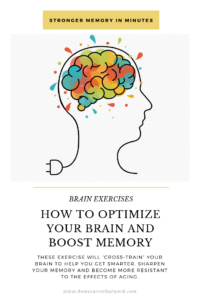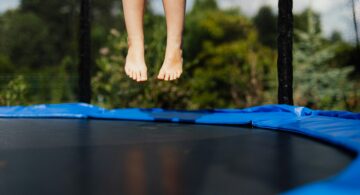How to Optimize Your Brain and Boost Memory
Keeping Your Mind Fit to Meet any Challenge
Red Skelton once quipped, “As you get older, three things happen. The first is your memory goes, and . . . I can’t remember the other two!”
Have you experienced a senior moment lately? Maybe you couldn’t find the car keys, your purse, or the car? How about names? And while we’re at it, how are you at math in your head—in public? Have you been driving lately and all of a sudden wonder, “Where am I?” Or perhaps you’re looking for just the right word in a conversation . . . but it eludes you . . . until three hours later when you’re standing in the shower! If any of those situations describes you, you’ll definitely want to read on!
Tongue-in-cheek, Mark Twain lamented, “Of all the things I’ve lost, I miss my mind the most.” However, we’ve got some great news for you; it doesn’t have to be that way with your mind or your memory!
Research by Lawrence Katz, PhD, professor of neurobiology at Duke University Medical Center, has revealed some exciting strategies for exercising the brain and improving memory. Dr. Katz coined the term neurobics to describe these cerebral calisthenics.[1] Neurobics are exercises that focus on keeping our brains agile and pliable.
The Science behind Neurobics
Like it or not, we humans are basically lazy! Not necessarily in the bad sense of the word. But we tend to make things easy for ourselves. (If you prefer to call it efficient, that’s okay.) We establish hundreds of little daily routines that enable us to complete most tasks without even thinking about them. For instance:
- When we get up
- The order and manner in which we groom ourselves
- What we eat (or don’t eat) for breakfast
- What we do while eating breakfast
- What route we drive to work
- What we listen to in the car
- Where we park
- How we get from our car to our office or work station
- What and where we eat for lunch, etc!
We do all these things mindlessly and in doing so, we’ve established neuropathways in our brains. These become well-worn paths in our brains. And like the creatures of habit that we are, we follow those pathways habitually—almost religiously. If you think I’m exaggerating, check your response and attitude next time one of those routines gets derailed by an unexpected event!
If we’re not careful, these neural pathways easily become ruts! Neurobics describes our willful disruption of those habits and the neural pathways associated with them. We simply choose to do something differently, or in a new way. This is said to release the hormone neurotrophin that opens up new neural pathways, expanding access to information and the way we process it. [2] If done on a regular basis, neurobics will help keep your mind fit to meet any challenge–whether it’s remembering a name, mastering a new computer program, learning to dance or staying creative in your work.
Neurobics is a departure from the popular brain-teasing games and puzzles available. A crossword puzzle or Sudoku can indeed help sharpen the mind, but the scope of their effectiveness is fairly limited to that specific activity. Becoming good at Sudoku, for instance, helps you . . . well, excel at Sudoku and similar tasks that involve numerical relationships.
With neurobics, you’re not relying on a game or puzzle, but integrating change in your everyday routines. In this way, all of life becomes our “neural gym.”[3]
Dr. Katz also emphasizes the power of engaging all five senses to the extent possible when making those changes. We’ve known for many years that the more senses you can involve in an activity, the more learning occurs and the more memorable it will be.
Finally, he encourages us to employ our emotions, which he refers to as our sixth sense. Our emotions offer a powerful signpost, reminding us what occurred when, how and why.
To summarize, neurobics involves these three elements:
- Break away from a normal routine or habit in everyday life
- Engage all five senses (sight, smell, sound, touch, taste) to the extent possible
- Invite your emotions to accompany your new experience[4]
Enemies of the Brain and Memory
Before we give you examples of neurobics, let’s look at some of the enemies of the brain. Think of these in terms of the environment in which you conduct your neurobics. Any one of these issues greatly hinders cognitive ability:
- Stress – Because improving one’s memory also has a lot to do with increasing one’s focus.
- Hurry – Hampers memory and learning
- Some drugs (e.g., memory loss is a side effect of statin drugs) – Kill brains cells
- Too little sleep – Because the brain needs sleep to consolidate new information
- Dehydration (not drinking enough water) – “Dry brain” decreases problem solving
- Lack of physical exercise – Increases the effects of aging on the brain
- Poor nutrition (eating processed foods and too much sugar) – Nutrient deficiencies can definitely impair your cognitive abilities
For maximum brain health and cognitive skill, minimize or eliminate these enemies or they will continue to work against you and the neurobic exercises will do little to help! For more information on these enemies of the brain and how to beat them, check out our Brain Health Kit.
Putting Neurobics to Work for Your Brain
What I like about neurobics is that it’s very individual. You have your specific neuropathways and I have mine. So the way you and I implement neurobics will be different. But consider the examples below and tweak them to fit your personality and situation or apply these principles to your own neurobic exercise.
A Trip to the Grocery Store
You no doubt have your favorite grocery store, the layout of which you have in your head. As a neurobic exercise what if you were to deliberately combine some or all of the following elements in your next shopping trip?
- Choose a different grocery store
- Go shopping at a time that’s unusual for you
- Either memorize your list, or write it down in a way that’s different than normal
- If you typically shop counter clockwise through the store, shop clockwise
- Intentionally browse the store a bit to discover items you never see in your usual store
- Try new brands that you’re unfamiliar with or haven’t tried in awhile
- Order something at the deli, meat or fish counter that you don’t normally order
- Mentally add the cost of each item in your head and see how close you come at the register
- Make sure you engage all five senses (sight, smell, touch, sound, and taste)
- As you shop, check your emotional status. What emotions are you experiencing?
- If you usually ask for plastic, this time have them bag your groceries in paper bags
- Think up additional changes you might make
Be careful. If you’re on a tight schedule, trying to follow through with the above example may only stress you out! And be aware that even when you knowingly change a pattern, you may feel some frustration. If you do, ask yourself, “Why is this frustrating me?” What can you learn from this situation? That’s why these exercises must be very deliberate with a view to stretching your mind.
Learn How to Dance
The New England Journal of Medicine published a study that concluded the best exercise to improve a person’s cognitive skills – whatever age you might be – is dance.
“The research, in fact, targeted senior citizens to determine which activity reduces the risk of dementia. As per the results, 76% of those who danced frequently exhibited lesser signs of dementia, compared to those who answered crossword puzzles and read often.[5]”
Dancing active regions of the brain that calculates spatial orientation, motor signals and emotional responses to choreography. So, dancing is the best leisure activity for ongoing brain health and maintaining intelligence.
Perhaps you have a secret desire to learn how to dance. But you’ve always said, “I can’t dance!”
- Denounce that proclamation and begin a search for dance instruction. (By doing this, you’ve already started moving out of your established neural pathways!)
- Begin attending dance classes and determine to meet new people.
- In order to meet new people, prepare two or three open-ended questions to engage others in conversation about themselves. (E.g., “What prompted you to start taking dance lessons?”)
- Make a conscious effort to learn people’s names. Write them down later to help with recall.
- During the week, practice your dance steps at home and practice the names of those you met.
- When you arrive at dance lessons next week, greet each person by name and engage them in light conversation.
Perhaps you’re thinking, “That’s way out of my comfort zone!” That’s the point!
Here’s a great brain and memory exercise for you to engage in right now: come up with your own neurobic exercise. Jump out of the ruts of your neural pathways and expand your mind!
The brain loves to be engaged with the novelty of new experiences. Your mind becomes bored with routine. Think through and plan what you’ll do and follow through with it. Take a bold step and get out of your comfort zone, maybe even learn how to dance. Make the lifestyle choice to exercise your brain and improve your memory – the side effects are fun, adventure and excitement!
Keep your brain active!























